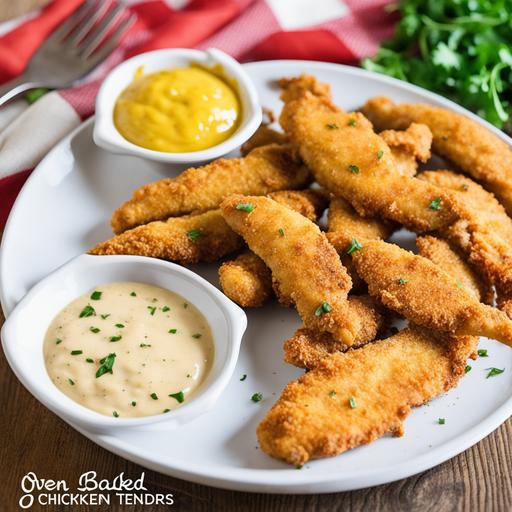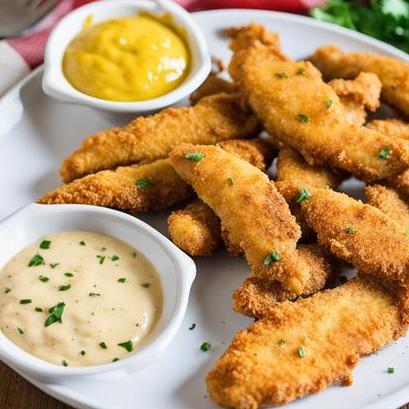
The Ultimate Guide To Chicken Tenders: Oven Recipe
Chicken tenders are a beloved favorite among both kids and adults. They are tender, flavorful, and incredibly versatile. Whether you are looking to prepare a quick and wholesome weeknight dinner or impress your guests with a delectable appetizer, chicken tenders are always a winner. In this comprehensive guide, we will delve into the intricate details of cooking chicken tenders in the oven, from selection to preparation, and everything in between. So, let’s get started!
Food Science: The Secret to Tender Chicken Tenders
Understanding the food science behind chicken tenders is vital to achieving the perfect, juicy result. Chicken tenders, which are essentially the pectoralis minor muscle, are located beneath the breast. This particular muscle is considerably tender due to its limited use during the chicken’s movement.
To enhance the tenderness of chicken tenders, it is important to marinate them prior to cooking. A marinade not only infuses flavors but also helps break down the proteins, resulting in a more tender and succulent piece of meat.
Culinary Details: Selecting the Best Chicken Tenders
Selecting high-quality chicken tenders is an essential step in preparing a delicious meal. Here are some key points to consider when selecting chicken tenders at your local grocery store or butcher:
-
Freshness: Opt for fresh chicken tenders rather than frozen ones if possible. Fresh tenders tend to have a better texture and flavor. Look for ones that have a slightly pinkish color with no signs of discoloration or unpleasant odor.
-
Size: Chicken tenders are naturally smaller than chicken breasts. However, try to select tenders that are relatively uniform in size to ensure even cooking.
-
Organic and Free-Range: If available, choose organic chicken tenders from free-range chickens. These tenders tend to have a richer flavor and are more ethically sourced.
Cleaning and Preparation: Setting the Stage for Success

Before diving into the cooking process, it is crucial to properly clean and prepare your chicken tenders. This ensures food safety and sets the stage for a delightful meal. Here’s a step-by-step guide to cleaning and preparing chicken tenders:
-
Rinse: Start by rinsing the chicken tenders under cold water to remove any surface impurities.
-
Pat Dry: Thoroughly pat the tenders dry with paper towels to eliminate excess moisture. This step allows for better browning during the cooking process.
-
Trim and Tenderize (Optional): While chicken tenders are naturally tender, you can further enhance their tenderness by gently tenderizing them using a meat mallet. Be cautious not to overdo it, as this may result in shredded or pulverized meat.
Tips for Success: Achieving Flavorful Perfection

To ensure your chicken tenders are bursting with flavor and cooked to perfection, here are some valuable tips:
-
Marinating: As mentioned earlier, marinating chicken tenders for at least 30 minutes enhances their tenderness and infuses delightful flavors. Consider using a combination of olive oil, lemon juice, garlic, and herbs or experiment with your own preferred marinade recipes.
-
Room Temperature: Before cooking, allow the chicken tenders to reach room temperature for about 15-20 minutes. This ensures even cooking throughout.
-
Preheating the Oven: Preheat your oven to 400°F (200°C) while you prepare the tenders. A preheated oven helps lock in the juices and maintains the tenderness.
-
Baking Sheet and Rack: For optimal results, place a wire rack on top of a baking sheet. This setup helps the chicken tenders cook evenly and prevents them from becoming soggy.
Variations: Exploring Endless Flavor Combinations

Chicken tenders provide an excellent base for experimenting with various flavors and cuisines. Here are some delightful variations to elevate your chicken tender game:
-
Crispy Parmesan: Mix grated Parmesan cheese with breadcrumbs, garlic powder, and Italian seasoning. Coat your chicken tenders with this mixture for a crispy and cheesy exterior.
-
Honey Mustard Glaze: Combine honey, Dijon mustard, and a touch of soy sauce. Brush this glaze over your chicken tenders while baking for a tangy and sweet flavor profile.
-
Spicy Cajun: Create a spice rub by combining paprika, cayenne pepper, garlic powder, and onion powder. Coat your chicken tenders generously before cooking to add a kick of heat.
Feel free to experiment with your own favorite ingredients and spices to create unique flavor combinations that suit your palate.
Checking Doneness: The Perfect Timing

Determining when your chicken tenders are perfectly cooked is essential to prevent them from being undercooked or overcooked. Here are a few ways to check for doneness:
-
Internal Temperature: Use a meat thermometer to measure the internal temperature of the chicken tenders. They should reach 165°F (74°C) for safe consumption.
-
Visual Check: Cut into the thickest part of a tender with a sharp knife. If the meat is white throughout with no signs of pinkness or rawness, it is fully cooked.
-
Texture Test: When lightly pressed, fully cooked chicken tenders should be firm yet tender to the touch.
Recipe: Oven-Baked Chicken Tenders
Now that you have all the essential tips and tricks at your disposal, here’s a basic oven-baked chicken tenders recipe to get you started:
Ingredients:
-
1 pound (450g) chicken tenders
-
1/4 cup olive oil
-
2 tablespoons lemon juice
-
2 cloves garlic, minced
-
1 teaspoon dried herbs (such as thyme or oregano)
-
Salt and pepper to taste
Instructions:
-
In a bowl, combine the olive oil, lemon juice, minced garlic, dried herbs, salt, and pepper to create the marinade.
-
Place the chicken tenders in a shallow dish and pour the marinade over them, ensuring even coverage. Allow them to marinate for at least 30 minutes, or refrigerate for up to 24 hours for maximum flavor.
-
Preheat your oven to 400°F (200°C). Place a wire rack on a baking sheet and lightly grease it.
-
Remove the chicken tenders from the marinade, allowing any excess to drip off, and place them on the wire rack.
-
Bake for approximately 15-18 minutes, or until the chicken tenders reach an internal temperature of 165°F (74°C).
-
Once cooked through, remove the tenderloins from the oven and let them rest for a few minutes before serving.
Overcooking and Undercooking: The Dilemma
It’s easy to overcook or undercook chicken tenders, leading to dry and unappetizing results. Here are some crucial points to keep in mind:
-
Overcooking: Watch your chicken tenders closely to avoid overcooking. They can dry out quickly, especially in a hot oven. Remember to use a meat thermometer and not to exceed an internal temperature of 165°F (74°C).
-
Undercooking: Undercooked chicken poses food safety risks. Always ensure that the chicken tenders are fully cooked by checking the internal temperature or cutting into them for visual confirmation.
Conclusion
With this comprehensive guide, you are now equipped with the knowledge and understanding to create finger-licking chicken tenders right in the comfort of your own kitchen. From selecting the perfect tenders to experimenting with delicious flavor combinations, and using the oven to achieve optimal tenderness, your chicken tender game will be strong. So, gather your ingredients and dive into the world of oven-baked chicken tenders, where culinary bliss awaits. Enjoy!
Sources
FAQS On Chicken Tenders Oven Recipe
Can I Use Frozen Chicken Tenders For This Oven Recipe?
Yes, you can use frozen chicken tenders in this recipe. However, it is recommended to thaw them first before cooking to ensure even cooking and prevent the chicken from becoming dry.
How Long Should I Bake Chicken Tenders In The Oven?
The cooking time for chicken tenders in the oven may vary depending on the thickness of the chicken and the temperature of your oven. Generally, it takes around 15-20 minutes at 400°F to cook chicken tenders in the oven. However, always use a meat thermometer to ensure the internal temperature of the chicken reaches 165°F.
Can I Use Breadcrumbs Instead Of Flour For Coating The Chicken Tenders?
Yes, you can use breadcrumbs instead of flour for coating the chicken tenders. In fact, breadcrumbs can give your chicken tenders more crunch and texture. You can even mix flour and breadcrumbs to achieve a perfect coating.
How Do I Make Sure The Chicken Tenders Are Moist And Tender After Baking?
To make sure your chicken tenders are moist and tender after baking, marinating them a few hours before cooking is a great way to lock in moisture and flavor. You can use any marinade of your choice, from teriyaki to garlic and herb. Also, avoid overcooking the chicken tenders as this can make them dry and tough.
Can I Make This Chicken Tenders Recipe Ahead Of Time?
Yes, you can prepare the chicken tenders ahead of time and store them in an airtight container in the fridge for up to 2 days. When ready to cook, preheat your oven and bake the chicken tenders according to the recipe instructions. This is a perfect meal prep idea for a busy week.



